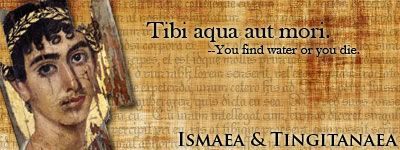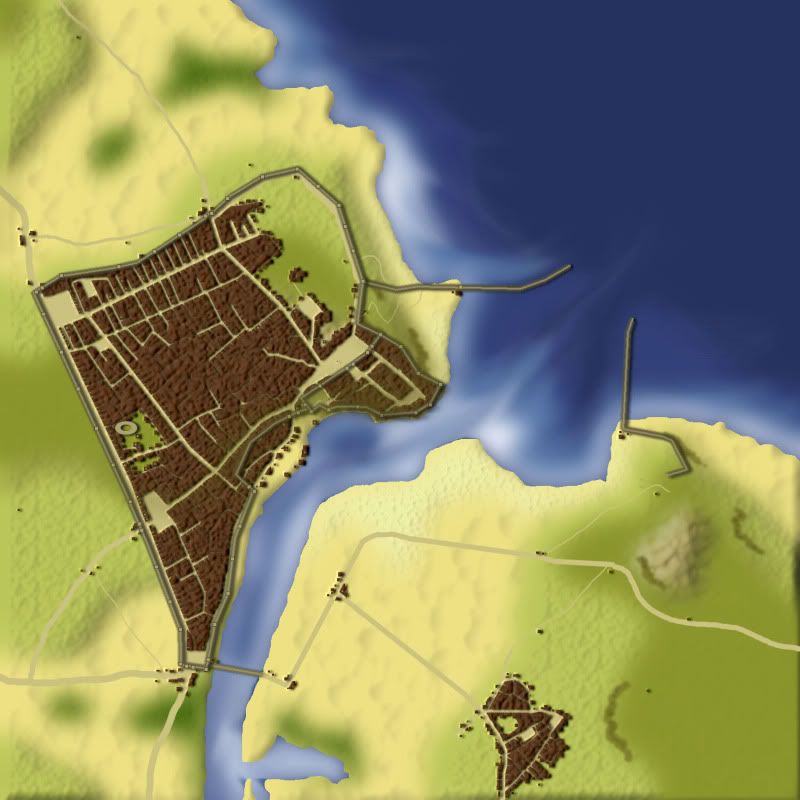Post by Ismaea & Tingitanaea on May 20, 2012 18:12:29 GMT -5
The Diocese of Ismaea and Tingitanaea

Diocese Color: Green
Major Gentillic(s): Tingitanaean (“dirt”/coastal Ismaean), Badoueen (inland) Ismaean, Tamarri, Amoraean
Languages spoken: various dialects of Ismaean, Tamarri, Amoraean
Seat of Diocese: Phoedetis Novapolis
Praesides: Tingitanaea, Ismaea
Background:
Although sharing a common tongue and culture, the people of Ismaea and Tingitanaea are in some ways as different from each other as they are of other nations.
Tingitanaea
Praeside Capital: Phoedetis Novapolis
Province(s): Tingitanaea Superior, Tingitanaea Inferior
Languages spoken: Amoraean (official, commercial, ecclesiastical), Coastal Ismaean (common vulgate)
Background:
Nearly all the arable land in the two praesides is located in Tingitanaea along the coast, and so Tingitanaeans are primarily farmers and traders fully incorporated into the Amoraean trade network crisscrossing the Shiraz Sea. Conquered by Amoraea relatively early (c. 81 B.C.E.), Tingitanaea has a pronounced Amoraean presence as well as a large number of Iesinorists.
Tingitanaea Superior
The most Amoraean-ized of all the provinces and the location of the diocese capital at Phoedetis Novapolis, an imperial-built port city dating back to the original conquest. Most of the province is composed of large estates producing wines, grains, and olives.
Tingitanaea Inferior
Less built up than Tingitanaea Superior, this province's seat of Nafur was the ancient capital of the region before falling to the Amoraean Empire in 82 B.C.E. Vineyards, olive groves, and small farms are characteristic of this province.
Ismaea
Praeside Capital: Bethaminael
Province(s): ‘Ard Aminael, ‘Ard Lai, ‘Ard Amori, Phoedetis Tamarrensis, ‘Ard Samiel
Languages spoken: Amoraean (official, commercial, ecclesiastical), High Ismaean (eccelesiastical), B’lad Ismaean (common vulgate), Tamarri (limited uses)
Background:
Unlike Tingitanaea, Ismaea has largely maintained its independence thanks to the harshness of its land and of its people. With nearly all of the land between Tingitanaea and the Tamaris River in the south a desert of rolling dunes and rocky flatlands, the people of Ismaea wander endlessly as nomads in search of grazing for their herds of camels or else cluster around the wells and oases that dot the arid landscape.
Despite the poverty of its soil, wealth flows through Ismaea in the form of caravans, which follow the trade routes that crisscross the country. With the wealth, however, comes unwelcome attention, and more than once invaders have sought to take Ismaea by force. They have always failed however; defeated by the trackless wastes of Ismaea's deserts and by the stubborn defense of its people, whose knowledge of their land allows them to cross great distances with very little water and strike an enemy at will with [/b]their bows, slings, and spears. Ismaea was only conquered in the 2nd Century C.E. by the Emperor Marcos II Aurelianos, who was able to claim victory after capturing Lorelai and forcing the Badoueen tribes to swear allegiance to the Empire. This was only done grudgingly, however, and outside of main settlements and the frontier forts the Imperial presence is virtually non-existent.
Ismaea is an intensely tribal society, and its tribes are grouped by house, with several Houses are powerful enough to effectively control parts of the country as their own personal domains. Although the Houses are constantly squabbling and at times even warring, they all defer to the Aminael, who rules out of Bethaminael as a priest-king for Ismaea and possesses greater influence than the Amoraean praeses.
‘Ard Aminael
Northwestern region controlled by the House of Ansari, who also traditionally serve as Shieldbearers of the Aminael (see below). Its capital is Bethaminael, which sits above one of the largest and cleanest aquifers in Ismaea and is also a nexus of trade, with goods and people from all over the world to be found in its markets and caravanserai. Bethaminael is garrisoned by the bucellarii of the praeses as well as a small force of comitenses, their numbers matched by the Guardians of the Aminael as well as by the forces of House Ansari.
‘Ard Lai
The central region of Ismaea consisting almost entirely of shifting sand dunes, its barren waste lightly spotted with wells and hidden oases. The largest of these oases is Lorelai, which together with Bethaminael is one of the only settlements in northern Ismaea large enough to be called a city.
Originally called “Saghri”, Lorelai was captured by Marcos II Aurelianos and turned into a major military outpost. Changing circumstances in the Empire forced the eventual withdrawal of Amoraean troops from Saghri, and the badly defended settlement fell to a surprise assault by the desert-dwelling House of Lai. Currently, Lorelai is a major waypoint on the caravan route and a base for raiders, who sell goods and slaves plundered from elsewhere in its markets.
‘Ard Amori
This southeastern region of Ismaea, characterized mostly by rocky desert extending to the Ophon Mountains in the south and the sea beyond, is the least centralized of any province in the praeside. Its notional capital is Iskendrun, an oasis town fortified by its namesake Alexander III Taurianos to cement imperial control over the frontier and the valuable salt mines nearby. In recent years direct Amoraean influence has dwindled as the provincial garrison and its ruling elites grew increasingly nativized.
Phoedetis Tamarrensis
In the distant past the city of Tamarra was the seat of a powerful river kingdom whose control stretched the length of the Tamaris River, but in the face of Amoraean power it chose to submit itself to the Empire as a client state. Today Tamarra is still wealthy and powerful, its irrigated fields producing great quantities of rice and sugarcane, and its harbor is filled with merchant vessels. It is ruled by a king, Yosif Ur-Rabin, who is nonetheless still responsible to the Amoraean praeses in Bethaminael, and Amoraean citizens enjoy favored status in Tamarra.
‘Ard Samiel
One of the other major families in Ismaea, the House of Samiel and its allies control the dry eastern grasslands and stony deserts extending to the foothills of the Lower Maurus mountains. Unlike elsewhere, the people of ‘Ard Samiel do not often possess camels but are instead shepherds and goatherds, and Bethsamiel is known for its colorful and intricate wool rugs.
Military Forces available:
At the time of the Empire’s fall, the only regular troops stationed in Tingitanaea and Ismaea were those of the Legio XII Flavia Constantiniana, whose comitatenses cohorts and attached cavalry were scattered in garrisons across the diocese. Since then the vicarios Gaios Porcios Dento has restructured the forces left under his command to replicate in miniature the imperial army of Amoraea, with the frontiers and more isolated outposts garrisoned by limitanei troops and allied cavalry supported by a mobile field army composed of the remains of the Legio XII and local levies.
Irregular forces can be found throughout the region and especially in Ismaea. Local militias and town guards are based throughout Tingitanaea, while the tribal warriors of Ismaea can be called to arms by the Aminael and fight under the banner of their own House.
The Ismaean warrior is mounted on a camel or desert pony and commonly carries a bow, sling, and several javelins which can be thrown or used as short lances. Swords and armor are heavy and expensive and thus limited to the wealthiest fighters, leaving the average Ismaean to rely on a wicker or leather shield and long knife for hand-to-hand combat. However, the Ismaeans avoid direct confrontation whenever possible, prefering to attack their enemy from a distance. When mustered together, the Ismaean army typically avoids open battle, drawing an invading army deep into Ismaean territory and harassing them with missile fire until heat and thirst begin to take their toll.
Religion
The inhabitants of Tingitanaea have for the most part come to embrace Iesinorism, but much of Ismaea continues to practice its own monotheistic faith, which is centered around the figure of the Aminael.
Although those who call themselves Ismaean know of God and know of His one thousand attributes, there is only one who can call him/herself Aminael ("Knower of the Name of God"). In knowing one true Name of God, the Aminael is able to summon God's full power to act upon the world, although the burden of such power is great and so used only in great need. The Name of God is passed from an Aminael to a successor chosen by God, and so the title of 'Aminael' passes not along dynastic lines but through divine will.
As the sole link between the mortal and the divine, the Aminael is also the designated leader of the true believers of God, and was traditionally responsible for governing the lands of Ismaea in times of peace and leading their armies in times of war. With the Amoraean conquest the political power of the Aminael diminished somewhat, but the unquestioned authority of the position is an important consideration in all political intrigue, and is usually manifested in struggles for the position of Shieldbearer.
As the ranking deputy of the Aminael, the Shieldbearer is responsible for enforcing the will of the Aminael and commanding the Aminael's personal bodyguard of heavily armored cavalry, the Guardians. The position of Shieldbearer is an inherited one which has been held by several different houses over the centuries, the most current of which is the House of Ansari.









